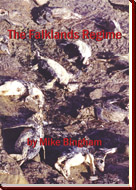 |
 |
| |
|
|
King Cormorant Local Name: King Shag Breeding Range: South America and
subantarctic islands King Cormorants breed in dense colonies on gentle cliff-top slopes at over 100 sites around the Falklands. Many of these colonies are mixed with breeding Rockhopper Penguins or Black-browed Albatross. Nests are constructed from mud and vegetation, with 2 to 4 eggs being laid around November. Eggs hatch in December, and chicks remain in the nest until they fledge in February. Adults travel long distances in search of schools of small fish and crustaceans, which they catch in flocks during shallow dives. King Cormorants remain around the Falklands throughout the year, and are easily distinguished from the Rock Cormorant by the continuos white throat of the former. Sexes are similar in appearance. The Falklands population has shown a significant decline over recent years. |
|
|
||||||||||||||||||||||||||||




